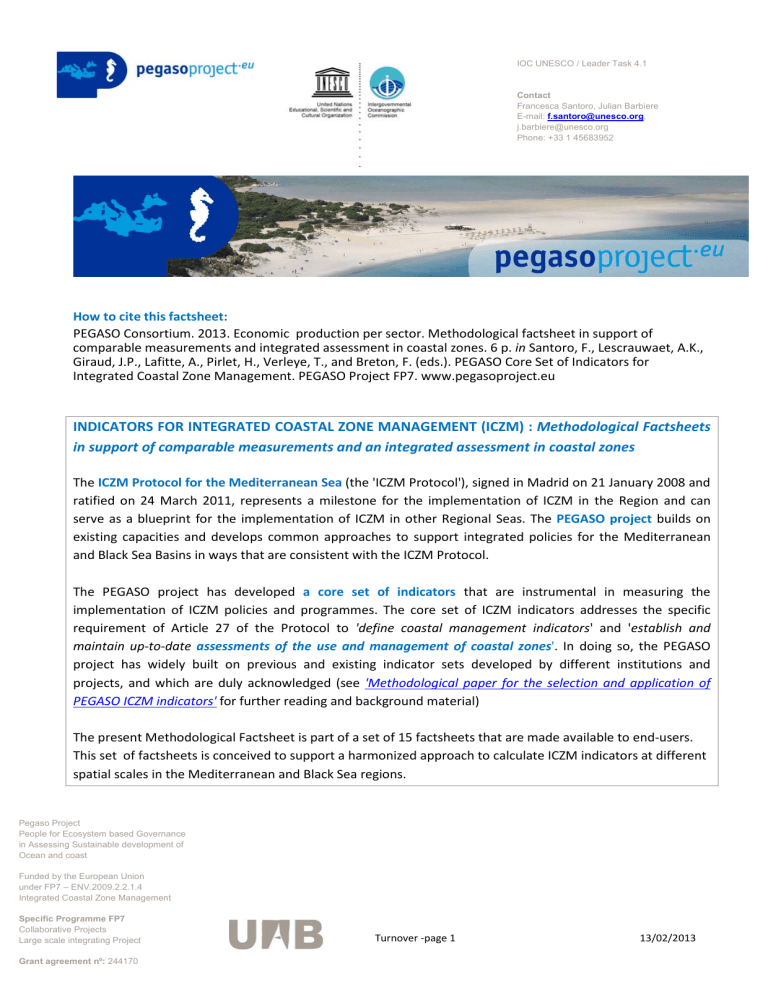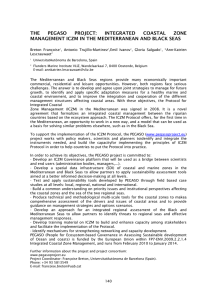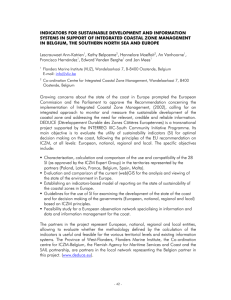Document 12460532

IOC UNESCO / Leader Task 4.1
Contact
Francesca Santoro, Julian Barbiere
E-mail: f.santoro@unesco.org
, j.barbiere@unesco.org
Phone: +33 1 45683952
How to cite this factsheet:
PEGASO Consortium. 2013. Economic production per sector. Methodological factsheet in support of comparable measurements and integrated assessment in coastal zones. 6 p.
in Santoro, F., Lescrauwaet, A.K.,
Giraud, J.P., Lafitte, A., Pirlet, H., Verleye, T., and Breton, F. (eds.). PEGASO Core Set of Indicators for
Integrated Coastal Zone Management. PEGASO Project FP7. www.pegasoproject.eu
INDICATORS FOR INTEGRATED COASTAL ZONE MANAGEMENT (ICZM) : Methodological Factsheets in support of comparable measurements and an integrated assessment in coastal zones
The ICZM Protocol for the Mediterranean Sea (the 'ICZM Protocol'), signed in Madrid on 21 January 2008 and ratified on 24 March 2011, represents a milestone for the implementation of ICZM in the Region and can serve as a blueprint for the implementation of ICZM in other Regional Seas. The PEGASO project builds on existing capacities and develops common approaches to support integrated policies for the Mediterranean and Black Sea Basins in ways that are consistent with the ICZM Protocol.
The PEGASO project has developed a core set of indicators that are instrumental in measuring the implementation of ICZM policies and programmes. The core set of ICZM indicators addresses the specific requirement of Article 27 of the Protocol to 'define coastal management indicators ' and ' establish and maintain up-to-date assessments of the use and management of coastal zones ' . In doing so, the PEGASO project has widely built on previous and existing indicator sets developed by different institutions and projects, and which are duly acknowledged (see 'Methodological paper for the selection and application of
PEGASO ICZM indicators' for further reading and background material)
The present Methodological Factsheet is part of a set of 15 factsheets that are made available to end-users.
This set of factsheets is conceived to support a harmonized approach to calculate ICZM indicators at different spatial scales in the Mediterranean and Black Sea regions.
Pegaso Project
People for Ecosystem based Governance in Assessing Sustainable development of
Ocean and coast
Funded by the European Union under FP7 – ENV.2009.2.2.1.4
Integrated Coastal Zone Management
Specific Programme FP7
Collaborative Projects
Large scale integrating Project
Turnover -page 1 13/02/2013
Grant agreement nº: 244170
ICZM Policy Objective
ICZM Protocol Article
Name of the Indicator
Economic Production per Sector (Turnover)
Objective of the indicator
The Protocol states that priority should be given to “public services and activities requiring the proximity to the sea” .
Economic activities are impacting the environment through resources consumption, pollution (both diffuse and from point sources), land use etc. But economic activities can also contribute to the social and economic development of a coastal zone by providing job and wealth creation. Thus it is important to elucidate to what extent each economic activity, taking place within the coastal zone, really contributes to the whole coastal economy. This will provide more insight in the dependence of the regional economy on the sea.
The indicator is a description of the relative importance of one sector of the coastal economy relative to another sector
(generally in comparison to their relative importance to the total economy of the management area). It describes the activity level within the coastal zone. Thus, it can be used as a proxy of pressure on coastal/marine resources to generate this turnover.
It is important to use this indicator together with the 3 other economic indicators (Pattern of Sectorial employment, Number of enterprises and Added value per sector).See the section on “Example of integrated assessment”.
Policy context
To give priority to public services and activities requiring the proximity to the sea, and to take into account the specific characteristics of the coastal zones when deciding about coastal uses
Article 9:
Economic activities (9.1e)
UNEP-MAP Ecological Objective
No reference to the UNEP-MAP Ecological Objective
INSPIRE ANNEX I-III Data Theme
(34)
Annex III
8- Production and Industrial Facilities (Annex III – 8)
Coverage
Coastal zone of the Mediterranean Sea
Coastal zone of the Black Sea
CALCULATION OF THE INDICATOR
Spatial consideration
•
•
•
Resolution
Coastal zone of the Mediterranean and Black Seas at NUTS2 level
Coastal zone of the Mediterranean and Black Seas at NUTS3 level
EEZ of countries in the Mediterranean and Black Seas
Note: the spatial reporting unit, or scale, may be defined by the issue or sector under consideration (see below)
Temporal consideration
Period Resolution (time interval or unit)
Time series should be as long as possible
Select a baseline, followed by reference points e.g. 2012, 2007,
2002 …
Note: the idea is to have time series as long as possible but also to have reference points every 5 years to catch trends. For seasonal activities, such as tourism, it is important to have monthly data for the most recent years.
Annual data. Measurements should be consistent in reflecting the situation for comparable reference points i.e. 1st of January or 31st of December every year.
Turnover - page 2 13/02/2013
Parameter(s)
Note:
1)
2)
The calculation method is given for NUTS3 level. It should be repeated for NUTS2 level.
For each parameter, the economic activities or sectors considered are the following:
Turnover per sector at national, regional and local level (billions/millions Euro) for the following sectors (if relevant for the area under consideration!)
• Submarine cables
• Shipbuilding and repair, scraping…
• Extraction (marine aggregates)
• Recreational Activities (Expenditures instead of turnover)
-Bathing
-Yachting and Sport
-Recreational fisheries (including shellfish)
• Offshore oil and gas-related industry
• Electricity power production interacting with marine environment (Marine renewable energy, Nuclear plants…)
• Living resources based activities
-Aquaculture
-Professional Fisheries (including algae)
-Seafood processing and marketing
• Maritime financial services (insurance, banks, supports…)
• Transport activity
-Harbours and supports
-Transport (people and goods)
• Maritime civil engineering (harbours, dams, dikes…)
• Other sectors and activities depending on or impacting coastal and marine environment (Agro industry, Food Processing,
Chemistry…)
-Agriculture
-Other industries
-Urban sprawl
-Coastal tourism (hotels, camping, restaurants, cafes)
(i) Turnover per sector, for sectors that are relevant in relation to the ICZM issue
Note: ‘relevant’ sectors are to be identified and selected according to a causal chain analysis (impacting sectors and impacted sectors). The turnover (billion of Euros) is defined at the scale of a reporting unit which is relevant for the issue or sector under consideration: e.g. river basin, coastal NUTS5/LAU2 etc.
(ii) If data at regional and local level are not available, the payroll employment (%) in each sector is to be used as an allocation key: multiplier average Turnover/employment for sector i
Calculation method
Steps
1 For each geographical scale, use the latest time series to identify the contribution of each sector and marine/coastal economy to the local/regional economy. Compare impacting and impacted sectors.
Products
Build the following table comparing national to regional and local turnover:
Sector
Sector n°1(S
1
)
Local
Turnover
Regional
Turnover
National
Turnover
Turnover - page 3 13/02/2013
Calculate of the relative weight of each sector to the global turnover:
Sector turnover / global turnover * 100
2 For each time series available, establish a bar chart
(one for regional scale and one for local scale) comparing Turnover for different sectors at different time scale. Bar charts can also be built for each sector and for the most recent time series to compare different areas (communes, sub-river basins...).
Sector n°2(S
2
)
…
Total
Total
(billion
100% 100%
Euros)
A table comparing national turnover to local turnover can be made (if data are available in national database)
Bar chart comparing turnover (billion Euro) per sector at different time scale
80
70
60
50
40
30
Year n-2
Year n-1
Year n
20
10
3 If regional and local data are not available, the payroll employment (%) in each sector can be used as an allocation key.
Example of calculation:
1 in regional payroll S
1E
% is the share of sector S employment
4 These keys (per sector) should be applied to the national turnover (per sector) to give regional value.
Example of calculation:
S
1T
is the turnover of Sector 1(in billion Euros) at national level.
Calculation of sector turnover at regional scale:
S
1T
* S
1E
%
5 For a Regional Assessment under transboundary constraints, the Turnover is not relevant and should be replaced by the Gross Domestic Product
(GDP). GDP is mainly available at national scale and not at local scale or for the coastal zone.
0
Sector 1 Sector 2
Allocation Key (in percentage) for each sector at regional scale
Regional (and/or local) turnover per sector (allowing the building of table and bar chart of step 1 and 2)
Derive the GDP per capita at the national scale and calculate the
GDP for the coastal population per country and Mediterranean or Black Sea coast. Aggregate GDP for coastal population at the scale of the Mediterranean or Black Sea.
Turnover - page 4 13/02/2013
Current monitoring
Use of the indicator in previous
Data sources
National Database, Multipliers from surveys or
National Accounts
Assessment context
The Balearic Indicators Project includes this indicator in its socio-economic indicators however, no factsheet, technical support or database are available yet.
assessments/initiatives
DPSIR framework
Driving forces
Link to anthropogenic pressure
Sustainability target or threshold
Link with other assessment tools
A high turnover, used as a proxy of pressure over the resources, indicates a high anthropogenic pressure on natural resources and ecosystems.
This indicator has to be read according to other economic indicator.
Example of integrated assessment
To get a full overview of the economic activity within the coastal zone. It is necessary to use this indicator together with the 3 other economic indicators.
The ratio turnover/employment allows the comparison between different sectors regarding their actual contribution to the local economy.
A high number of hypoxia events can be related to intensive agriculture within the coastal area
Scope for future improvements
Field surveys can be conducted to get a better estimation (when data are not available).
Indicator references (i.e. UNEP, EEA, …)
Note: factsheet content drawn by the PEGASO partner University of Brest.
Turnover - page 5 13/02/2013






